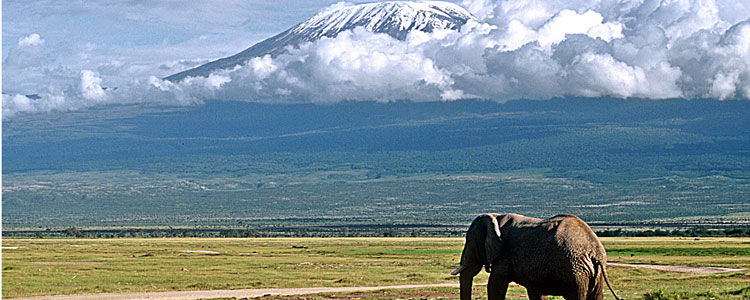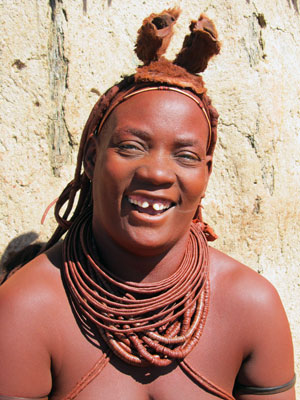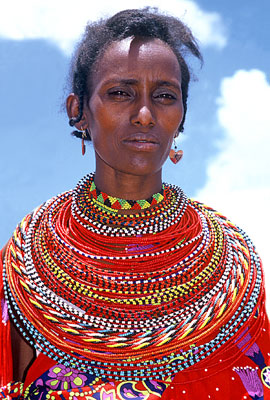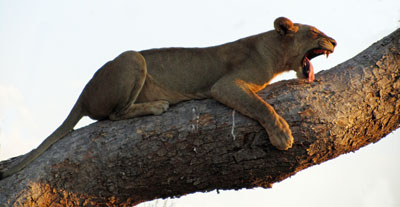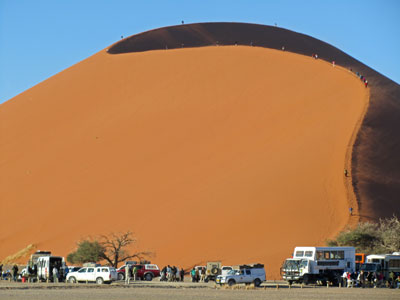Cape Town to Nairobi—an overland safari
by Jim Hendrickson, Lynden, WA
In August 2010 I began an unforgettable safari with Nomad Adventure Tours (Cape Town, South Africa; phone +27 [0] 21 426 5445, www.nomadtours.co.za). This 42-day journey began in Cape Town, South Africa, taking our group to Victoria Falls, Zimbabwe, and on to Nairobi, Kenya — a total distance of 6,600 miles.
Starting out
I joined 14 people, mostly Germans, along with our driver/guide, cook and German interpreter, on an overland tour in a truck specially equipped with an onboard kitchen and, in the passenger section, reclining seats.
From Cape Town we headed north and entered Namibia over good asphalt roads. We made many stops along the way, including several to visit gigantic sand dunes, one of which we climbed in a horrific windstorm. On another interesting stop, we saw huge communal nests of the sociable weavers that covered entire trees and could hold up to 400 birds.
We spent one morning with the seminomadic Himba people. The women cover themselves with a reddish mixture of butter fat, ochre and herbs for protection from the sun.
Crossing the vast Kalahari Desert required considerable stamina and patience because the traveling days were long, hot and dusty, yet it was definitely worth the many friendships, memories and photographs we all treasured from the experience.
We stayed in mostly no-frills motels and lodges with bedrooms that were clean and safe and had facilities en suite. Some of the lodgings had small swimming pools, providing a welcomed respite at the end of a day.
Our cook prepared very simple but nutritious meals that we enjoyed sitting in folding canvas chairs. Breakfast consisted of various cold cereals, yogurt, wheat bread, butter and jam plus coffee or tea. We stopped alongside the road for lunches of make-your-own sandwiches and salads of tomatoes, cucumbers and onions. For dinner, our cook prepared either stewed chicken or beef served with pasta or boiled rice and a side salad.
Memorable moments
The thing I enjoyed most during this first leg of the safari was a two-day visit to the Okavango Delta in Botswana, the world’s largest inland delta. An estimated 200,000 large mammals live there, and we saw African bush elephants, Cape buffalo, hippopotamuses, giraffes, lions, greater kudus, sable antelopes, zebras, warthogs, baboons and a plethora of the delta’s more than 400 species of birds, including the African fish eagle.
We overnighted in individual thatched bungalows, each with a marvelous view of the small islands and waterways.
While I was hiking around the lodge’s premises with two friends, we encountered an adult male elephant, locally called Mr. Ele, who was munching on some tree branches nearby. As we photographed him, he suddenly noticed us and stared angrily in our direction. We froze for a few moments, then very slowly tiptoed around the massive mammal once it continued feeding.
Safely back at our lodge, we were astonished at the photographs and videos we had taken during our frightening 45-minute encounter. Mr. Ele had made our day!
The finale of our three-week safari, the first half of my tour, was a visit to one of the Seven Natural Wonders of the World: Victoria Falls. While it is neither the highest nor the widest waterfall in the world, when taking into consideration all dimensions and its flow rate, it is claimed to be the largest. The falls are formed as the full width of the Zambezi River plummets in a single vertical drop into a chasm 200 to 400 feet wide — a spectacular sight!
During this safari there were many opportunities to purchase a wide variety of souvenirs, but the one that appealed most to me was the Zimbabwe one-hundred-trillion-dollar bill (that’s $100,000,000,000,000!). Worth around $30 when it was released, today it is worthless, except as a souvenir. Zimbabwe now uses only American dollars as its currency.
A bumpy ride
The second leg of my safari was more adventurous and challenging than the first part. An Australian fellow from my first tour and I boarded a different overland truck together with an international group of 10 campers plus a new driver/guide and cook.
Leaving Zimbabwe, we drove northeast through the Republic of Zambia and continued to its capital, Lusaka. So far, so good. But when we entered Malawi, the roads began to deteriorate before our eyes. The asphalt surface quickly became dirt, potholed and extremely dusty. A steady stream of heavy trucks, minibuses filled to overcapacity, speeding motorbikes and four-wheel-drive vehicles bumped relentlessly in both directions along the corrugated highway.
As we sped along at 40 to 50 miles per hour, I endured thousands of jolting bumps that shook my entire body like an old-fashioned washing machine. I have never ridden over such dreadful roads anywhere in the world.
As I looked out my dust-covered window, I breathed clouds of dust that my lungs rejected, resulting in a great deal of coughing. Sucking on cough drops relieved the situation temporarily.
When our overland truck rolled by homes in the bush, children came running out to the road and began shouting with joy, smiling and waving excitedly at us. We waved back and smiled. And so it went — all the way down the dusty road for hundreds and hundreds of miles.
Winding down
After we entered Tanzania, we ascended out of the Great Rift Valley through some spectacular mountain passes, passing vast tea plantations in the highlands. We rolled across central Tanzania, which comprises a large plateau with plains and arable land.
Hot, humid air welcomed us to the historical port city of Dar es Salaam, the largest city in Tanzania.
A ferry took us to the island of Zanzibar, lying just offshore, where we explored its historical and unique architecture, visited its spice and seafood markets and, later, spent two days relaxing on the beach on the northern part of the island.
After a stop in Arusha, back on the mainland, our adventurous safari came to an end in Nairobi, the capital and largest city of Kenya.
This entire six-week tour was one of the best values for my travel money that I have ever found. I paid $6,211, which included all ground transportation, the assistance of very professional and personable crews, accommodation and single supplement and three meals daily.
I rate this Nomad safari very highly and recommend it.

